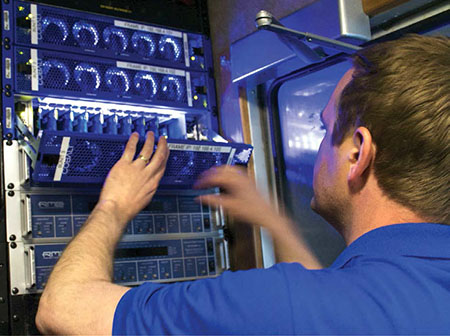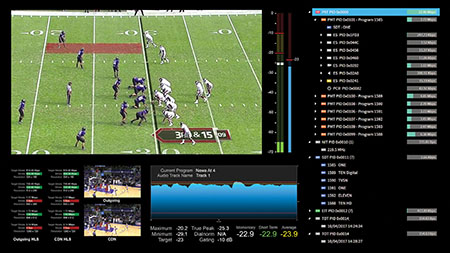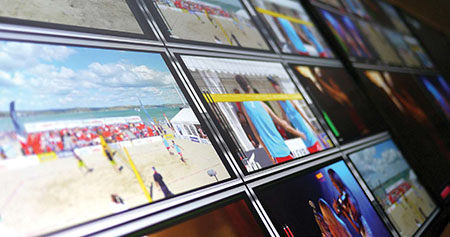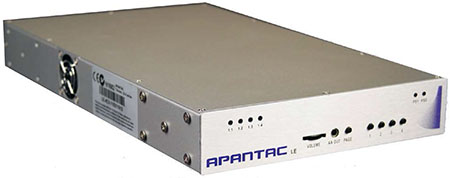Multiviewers Dominate Sports Monitoring
ALEXANDRIA, VA.—Multiviewers have changed the way video is monitored every place video needs to be monitored. From security applications to the Academy Awards to the Super Bowl, nobody creates video today professionally without monitoring it using multiviewers.

Kyle Wilken of Cobalt Digital inspects the company’s 9970-QS cards on NCP mobile production truck.
Compared to the alternative—using individual monitors for each signal—multiviewers hold many advantages. Three of the biggest are that they allow monitoring to occur in a much smaller space; using multiviewers creates much less heat; and highquality monitoring is far less expensive with multiviewers. Cheaper, better, cooler... it’s the trifecta of benefits.
In particular, working with multiviewers scores big time with sports producers. With most big-league sports produced out of remote trucks, multiviewers are prized for their reduced footprint, lower heat generation and greater ruggedness over the alternative of individual monitors. Most high-end sports production today takes place using 4K-capable production trucks, so multiviewers have had to keep pace with the 4K world.
“When it comes to live production, sports has always been on the forefront of innovation,” said Mark Horchler, senior vice president of marketing for Australia-based Mediaproxy.

Display using a Mediaproxy Monwall multiviewer
DISPLAY FLEXIBILITY
Horchler said that display flexibility is key for sports producers, something that fits well with Mediaproxy’s software-based multiviewers.
Get the TV Tech Newsletter
The professional video industry's #1 source for news, trends and product and tech information. Sign up below.
“A software-based multiviewer enables it to keep up with the latest technologies such as HEVC and MPEG-DASH,” he said. “As a member of the AIMS Alliance, the Mediaproxy Monwall multiviewer is being integrated within new IP-based live-production workflows. As standards for IP video continues to evolve, customers—especially sports broadcasters—will be able to benefit.”
Cobalt Digital, which introduced a 4K multiviewer module at the 2017 NAB Show, takes a different approach to multiviewers than most, with a modular system that can be cascaded to create complex displays.
“[Our] core customer base is sports production,” said Bob McAlpine, CEO of Champagne, Ill.-based Cobalt Digital. “Our new 9971-MV6-4K platform is cascadable and very similar in concept to the QS series but instead of five inputs, it has six and instead of 3G-SDI, the MV6-4K supports 12G-SDI on each of its coax inputs. An 18-input version will also be available, as well as a version that adds four HDMI 2.0 inputs to the six coax.”
Two of Cobalt Digital’s customers—NEP and CSP Mobile Productions—are popular providers of production trucks for large sports events.

SAM Multiviewer display
4K PRODUCTION
Concerning the adoption of 4K as a production standard for high-end sports, what are the right questions to ask when shopping for multiviewer systems?
“Is the input density right?,” asked Peter Timmons, product manager for multiviewers at U.K.-based Snell Advanced Media (SAM). “With the increased resolution of 4K displays and associated sizes, it is now possible to increase the number of sources displayed on a single multiviewer screen without affecting the image or scaling quality.”
Timmons also suggests that customers ask whether the supplier can provide all form factors that they may need using the same technology, setups and man-machine interfaces.
Also, can the supplier flexibly support UHD/4K inputs and outputs, as well as UHD/4K over IP?
Does the supplier have other technologies to reduce the cost of operations in multiviewing environments, and are control and monitoring tools integrated within the multiviewer?
Timmons pointed out that SAM’s multiviewers feature one frame of latency and can monitor up to 32 channels of audio with 16 onscreen displays per source, both important features for fast-paced live sports production.
Although sports production is moving quickly to 4K, that doesn’t mean that everything needs to be changed to a 4K device.

Apantac Tahoma-LE-4 multiviewer
“Even though sports production is going 4K, most of our customers are monitoring in 3G,” said Thomas Tang, president of Portland, Ore.-based Apantac. “It is important to be able to accept 4K, but it isn’t a requirement that every input should support 4K. Flexibility is the key.”
Going beyond production trucks, Tang said that Apantac’s multiviewers’ light weight, small size and low-power consumption make them ideal for flight packs and other compact production systems.
What about high dynamic range?
“We believe that 4K will only fly if it will come together with HDR,” said Felix Krückels, director of business development for Germany-based Lawo. “That means that the multiviewer also should be able today, or at least in the future, to support HDR. Both formats, UHD and HDR, will be for a long time combined with all existing formats we have today such as SD, HD, 3G and others, which is another common request we get for our multiviewer.”
SOFTWARE-ONLY
Cinegy took a completely different path to its multiviewers—it is a software-only product that runs on a PC and works with the computer’s display card to provide multiviewer display. The company has set its software up for NVidia display cards but doesn’t rule out working with other card manufacturers.
“We get ‘best of both worlds’ benefits,” said Lewis Kirkaldie, head of product management at the Germany-based company. “As software, we can use NVidia GPUs to drive down the cost of the platform and get 16 HD decode streams from a single board [and we support up to four boards]. The world is changing quickly to IP, and we are lucky to be able to use this technology to offer customers traditional SDI monitoring, SMPTE 2022-6 uncompressed or H.264 compressed streams.”
Kirkaldie pointed out that Cinegy’s software approach has allowed it to provide some advanced features that include support for decoding all subtitle standards, as well as adding HEVC monitoring.
Two of Cinegy’s sports customers include Sports Editing Sweden for the Swedish hockey league, and Dogan TV.
Many companies have multiviewers, including Blackmagic Design, Evertz, Grass Valley, Imagine Communications, Craltech, Decimator Design, Matrox, Mividi, Swit and Kramer. Some companies, such as Panasonic, Blackmagic Design, For-A, Grass Valley, SAM, Sony, Roland and Ross Video either have multiviewer capability built into production switchers or offer it as an option. And this latter choice is not just for smaller operations—you can get a powerful production switcher that includes multiviewer output with every possible bell and whistle.
Multiviewers are not just for sports production, of course. They are pretty much indispensible for all live video production and large-scale monitoring, which is why they are now so common and affordable.
There are a lot of choices out there, and some may be better choices for you depending on the production gear you already own.
Bob Kovacs is the former Technology Editor for TV Tech and editor of Government Video. He is a long-time video engineer and writer, who now works as a video producer for a government agency. In 2020, Kovacs won several awards as the editor and co-producer of the short film "Rendezvous."

